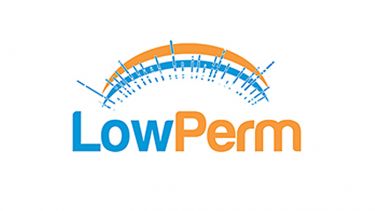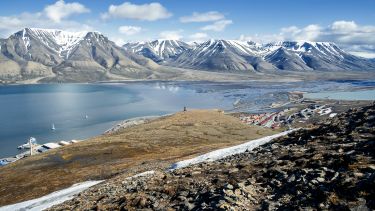LowPerm
Launched in 2015 and funded by the EU under the Joint planning initiative, LowPerm sought to understand nutrient transport within permafrost landscapes and how these lead to changes in greenhouse gas production and fertilisation of the Arctic Ocean.

About
The LowPerm project used an integrated programme of field work, laboratory experimentation, numerical modelling and workshops to tackle these areas. The project used Russian and Norwegian field logistics from West Spitsbergen to Siberia, and laboratories in the UK and Denmark.
Major polar science practitioners from outside the consortium with expertise in regional modelling, isotope geochemistry, marine ecosystem change, and biogeochemical cycling, enhanced the international profile and impact of the project through knowledge exchange activities.
LowPerm aimed to:
- Quantify microbial processes, changes in microbial populations and their functional potential.
- Understand the physical process dynamics of permafrost soils at field observatories in West Spitsbergen.
- Quantify seasonal microbial-driven greenhouse gas production and fjord fertilisation, due to runoff of nutrients and organic matter.
- Determine responses of microbial communities to different temperatures, water, oxygen, and nutrient substrate conditions.
- Develop semi-empirical tuning parameters for integrating these biogeochemical processes into biophysical models, taking the small-scale into account.
The importance of the oceans for heat transfer into the Arctic means that the low altitude and very extensive permafrost lowlands can respond quickly and significantly to climate change. In the Eurasian Arctic this causes the early onset of thaw, increased active layer thickness and enhanced microbial activity. The vast soil carbon stocks of Arctic permafrost are vulnerable to these changes, but accurate forecasting of its influence on the global climate system relied on addressing a number of knowledge gaps.
The following such gaps were addressed by LowPerm:
- Understanding of the microbially mediated processes in the permafrost interface and how they control the production of new biogases and nutrients in response to increased global temperatures. Prior to this project, there was poor understanding of the hydrological, geomorphological and ecological drivers of these biogeochemical processes. Results of this research were to be incorporated into more accurate regional models.
- Investigating the fertilisation potential of runoff from permafrost lowlands. Runoff from lowlands in the Eurasian Arctic is an important source of iron, nitrogen, phosphorus and organic matter to marine ecosystems. Such chemicals entering the sea will change biologically produced CO2 levels which in turn will alter these ecosystems.
Team
Principal investigator
Professor Andy Hodson, the University of Sheffield
Co-investigators
Professor Hanne Christiansen, UNIS
Professor Kai Finster, Aarhus University
Dr. Jacob Yde, HISF
PostDoc researchers
Dr. Gunnar Mallon, the University of Sheffield
Dr. Ebbe Norskov Bak, Aarhus University
Brendan O'Neill, UNIS
Dr. Aga Nowak, the University of Sheffield
PhD researcher
Eleanor Jones, the University of Sheffield
Outputs
Andrew Jonathan Hodson, Aga Nowak, Kelly Robert Redeker, Erik S. Holmlund, Hanne Hvidtfeldt Christiansen and A V Turchyn, 2019. Seasonal dynamics of methane and carbon dioxide evasion from an open system pingo: lagoon pingo, Svalbard Frontiers in Earth Science, doi.org/10.3389/feart.2019.00030
Gilbert, G.L., O'Neill, H.B., Nemec, W., Thiel, C., Christiansen, H.H., Buylaert, P., 2018. Late quaternary sedimentation and permafrost developmentin a Svalbard fjord-valley, Norwegian high Arctic. Sedimentology, DOI: 10.1111/sed.12476
O'Neill, H.B., Christiansen, H.H., 2018. Detection of late quaternary sedimentation and permafrost developmentin a Svalbard fjord-valley, Norwegian high Arcticce Wedge Cracking in Permafrost Using Miniature Accelerometers. Journal of Geophysical Research: Earth Surface, DOI: 10.1002/2017JF004343
Betlem, P., Senger, K., Hodson, A. 2018. 3D thermobaric modelling of the gas hydrate stability zone onshore central Spitsbergen, Arctic Norway. Marine and Petroleum Geology, doi.org/10.1016/j.marpetgeo.2018.10.050
Hodson et al., 2017. Climatically sensitive transfer of iron to maritime Antarctic ecosystems by surface runoff. Nature Communcations, DOI: 10.1038/ncomms14499
O'Neill et al., 2017. Near-surface ground ice variation in ice-wedge polygons in Adventdalen, Svalbard. Arctic Science Summit Week 2017 (Poster), Prague, Czech Republic. PDF (7.7MB)
Bak et al., 2017. Electron acceptor-based regulation of microbial greenhouse gas production from thawing permafrost. EGU 2017 (Poster), Vienna, Austria. PDF (3.77MB)
Jones et al., 2017. Redox and biogeochemical processes inferred from permafrost porewater extractions. EGU 2017 (Poster), Vienna, Austria. PDF (4.67MB)
Hodson et al., 2015. Glacial and periglacial floodplain sediments regulate hydrologic transfer of reactive iron to a high arctic fjord. Hydrological Processes, DOI: 10.1002/hyp.10701
Mallon et al., 2015. LowPerm: quantifying thaw-driven biogas production and nutrient export from Eurasian Arctic lowlands. Arctic Science Conference 2015 (Poster), Sheffield, UK. PDF (1.43MB)
Nowak et al., 2015. On the biogeochemical response of a glacierized High Arctic watershed to climate change: revealing patterns, processes and heterogeneity among micro-catchments. Hydrological Processes, 29, pp. 1588-1603. DOI: doi/10.1002/hyp.10263/abstract













